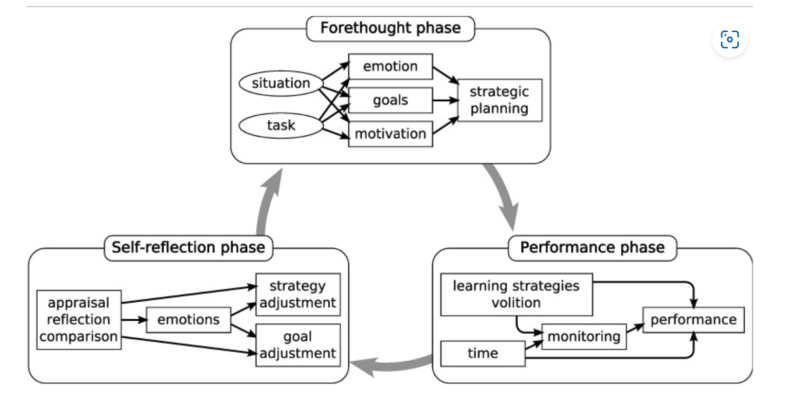Jennie J. Jones’s Updates
Update 1: Student-facing Analytics
One of the most impactful learning technologies in current use is that of student-facing analytics within learning managements systems such as the Analytics tool within CG Scholar. This tool, though traditionally helpful for the teacher/trainer to provide a wider picture of engagement in learning, is indispensible for the learner to track their own progress. This particular itemized analytics tool works by tracking student progress over a plethora of data points which encompass an analysis of student actions within a course of instruction. For example, In Figure 1, the learning designer has created opportunities for tracking student engagement with admin updates, update creation, effort toward updates, review effort etc. Because of the visual representation of the aster plot anaytics tool, the student can easily ascertain the amount of participation in a current course, the necessity for further completion in particular areas, and even experience a dopamine release when the analytics tool, based of computer artificial intelligence, is quickly updated daily. In a recent study of this analytics tool in progress, William Cope described an 8th grade class of students, who had interacted in online discussion and written a peer reviewed project, gave and received 1,172 pieces of actionable feedback and had their results analyzed based on nearly 150,000 tiny datapoints (Cope&Kalantzis, ). Certainly, no teacher could assess so many data points for each student in such a short amount of time. Further, the deisgn of the analytics tool allows for a full range of demonstrating engagement, discussion, reviewing, and writing collaboratively, providing a much wider understanding of student involvement in their education.
Moreover, the analytics feature in CG Scholar supports the concept of self-regulation in learning that is so important to the success of the student in higher learning. Students are motivated to review their process of learning in real time, instead of receiving their summative evaluation when they can do very little to implement recursive feedback and learner growth. Student-facing analytics benefit the learning activities of students in three major ways:
- Summative: understand learning habits, compare learning paths, analyze learning outcomes, track progress towards goals
- Real-time: receive automated interventions and scaffolds, take assessments including just-in-time feedback
- Predictive: optimize learning paths, adapt to recommendations, increase engagement, increase success rates (Ifenthaler, Widanapathirana, 2014b).
When considering digital learning environments and their multi-faceted and often non-linear presentation of learning opportunities, students demonstrate autonomy in choosing what to do and when. The open nature of these choices necessitates a way to be motivated to tackle the wide array of activities within the class and somehow track the activities. The analytics feature provides an easy, visual way to self-monitor the learning process quickly and easily. This tool allows for the cyclical self-regulated learning process to occur more readily in the digital learning environment.
Most education theorists agree that this process (Figure 2) consists of three phases: 1) In the forethought phase, learners analyze the task, plan their activities to reach their goals, influenced by (academic) self-concepts, motivation, (meta-)cognitive knowledge about themselves, the task, and the context. 2) The performance phase is where the actual learning process occurs. Achieving a successful learning outcome involves applying suitable learning strategies and spending sufficient time on learning. 3) In the final self-reflection phase, learners reflect on and evaluate the learning outcomes in terms of effort and success. This internal or external feedback influences attributions, motivation, and self-efficacy beliefs of learners and might thus lead to modifications.(Schumaker&Ifenthaler, 2018).
The loop of these three phases closes again with consistent review of the analytics tool in order to have a clear picture about when strategies for learning should be revisited or recursive feedback is necessary to improve upon the outcomes of classroom activities. It can provide the motivation necessary to follow through with each task in a visual way. Because of these features, it is a fantasic tool to use in support of all kinds of students, neurotypical and neurodiverse alike.
Cope, W., & Kalantzis, M. (n.d.). Schools after COVID-19: Seven Steps Towards a Learning Revolution. University of Illinois College of Education. Retrieved August 25, 2023, from https://cgscholar.com/community/community_profiles/new-learning/community_updates/117304
Ifenthaler, D., & Widanapathirana, C. (2014b). Development and validation of a learning Analytics Framework: two case studies using support vector machines. Technology, Knowledge, and Learning, 19(1–2), 221–240. https://doi.org/10.1007/s10758-014-9226-4
Schumacher, C., & Ifenthaler, D. (2018). Features students really expect from learning analytics. Computers in Human Behavior, 78, 397–407. https://doi.org/10.1016/j.chb.2017.06.030




With fast-paced gameplay and easy-to-learn mechanics, Baseball Bros lets you dive straight into the action, perfect for casual players and baseball enthusiasts alike.
Basketball Stars This analytics tool sounds like a game-changer for both students and teachers! Having real-time feedback can drastically enhance learning experiences. I wish I had something like this in my own academic journey; it might have helped me better track my progress and areas for improvement. Thank you to the admin for creating such an innovative approach!
google
It is intriguing to see how basketball stars use strategy throughout games. To help their teams win, they are able to read the game and make split-second decisions.